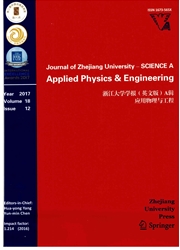

 中文摘要:
中文摘要:
目的:在市政供水管网系统中,由冲刷引起的管道内壁生物膜脱落可能造成饮用水二次污染。本文旨在通过研究冲刷前后生物膜理化特性和微生物种群结构的变化,探讨不同金属管材管道和不同冲刷流速对生物膜脱落的影响,从而为管道生物安全的风险评估提供科学依据。创新点:不同菌属的细菌对水力冲刷的敏感程度不同;各菌属对水力变化的敏感程度既与菌属本身的性质有关,也与其附着生长的管材有关。方法:1.采用R2A培养基平板计数、16S rD NA检测、荧光定量聚合酶链式反应及454焦磷酸测序技术。2.通过理化指标检测与测序相结合的方式进行分析,并以丰度图和热度图的形式呈现结果。结论:1.球墨铸铁管内壁生物膜的抗水力剪切能力较强,能够抵抗低剪切冲刷,在高剪切力冲刷后才会明显脱落,而灰口铸铁管和不锈钢复合管内壁生物膜的抗水力剪切能力较弱,低剪切力冲刷工况便会导致生物膜的明显脱落。2.生物膜对冲刷的抵抗作用在其群落的属水平和纲水平上有显著变化,这与群落本身和管材特性均有关联。
 英文摘要:
英文摘要:
Biofilm detachment caused by flushing can result in secondary contamination in drinking water distribution systems (DWDSs). To evaluate the impact of flushing on biofilm detachment, actual water supply pipes including ductile cast iron pipes (DCIPs), gray cast iron pipes (GCIPs), and stainless steel compound pipes (SSCPs) were used in this study. Real-time quantitative polymerase chain reaction and 454 pyrosequencing were used to quantify bacteria and analyse microbial community composition, respectively. The results showed that the pipe material greatly influences the resistance ofa biofilm to flushing. Biofilms attached to DCIPs were able to resist quite strong flushing, while those attached to GCIPs and SSCPs were sensitive to flushing. Both flush-resistant and flush-sensitive bacteria were present in all the biofllms, but their frequency differed among the different metal pipes. Thus, the resistance to flushing of bacteria is related not only to the nature of the bacteria, but also to the pipe material. Although flushing can remove some of the biofllm and may be a good way to clean the DWDS, the shear stress needed to remove the biofilm differs among different pipe types. The results of this study provide technical support for the management and opera- tion of DWDS.
 同期刊论文项目
同期刊论文项目
 同项目期刊论文
同项目期刊论文
 期刊信息
期刊信息
